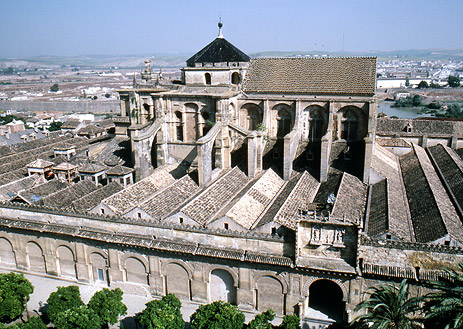Image Resource Bank
Image Gallery |  14 of 15
14 of 15 
A Muslim Mosque Converted Into a Church
Like many holy places, the site of the Mezquita (from Arabic masjid, “mosque”) of Córdoba, Spain, has been re-used by a new faith as the dominant local religion changed. The place may have begun as a pagan temple in Roman times, but under the Visigoths it became a small church. With the change to Islamic rule in 711 CE, this church went out of use, and in 784 CE the emir of al-Andalus, ‘Abd al-Rahman I, ordered the construction of a massive new mosque on the site, for a long time one of the largest in the Muslim world. Subsequent Muslim rulers expanded the original prayer hall and courtyard, built the minaret (from which the photo was taken) and added more sumptuous decoration. Arched porticoes resting on many rows of columns cover the large rectangular prayer hall; the sloping roofs of the porticoes can be seen clearly in the photograph. After Córdoba fell to the armies of the Christian kings of Castile in 1236, the mosque was converted into a church. In the 1520s, a basilica-plan cathedral was begun in the middle of the former mosque enclosure; it took 300 years to complete, and can be seen rising above the porticoes.
Name: Mezquita of Córdoba
Material: Granite, marble, onyx, jasper
Size: Over 23,000 square meters (Over 248,000 square feet)
Date: 8th to 18th centuries CE
Place of Origin: Córdoba, Spain
Location: Córdoba, Spain
Registration # and Source: Photograph by Fred M. Donner, July, 1985 CE
Material: Digital photograph from 35mm slide
Size: Unknown

 Fred M. Donner
Fred M. Donner
Professor of Near Eastern History, University of Chicago




